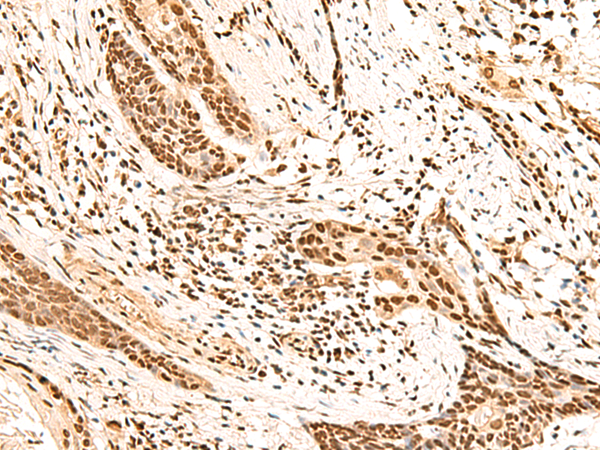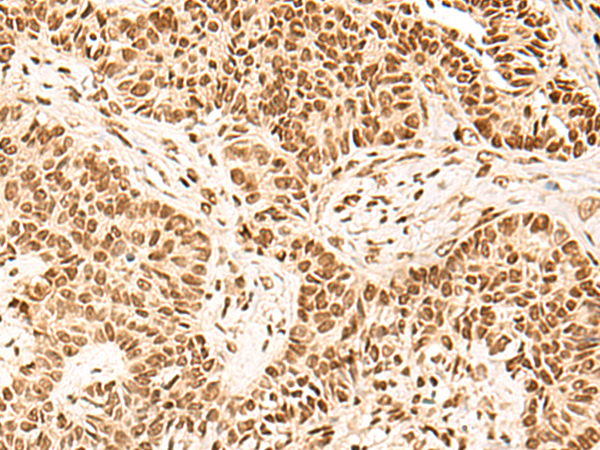

| WB | 1/1000 | Human,Mouse,Rat |
| IF | 咨询技术 | Human,Mouse,Rat |
| IHC | 1/100-1/500 | Human,Mouse,Rat |
| ICC | 技术咨询 | Human,Mouse,Rat |
| FCM | 咨询技术 | Human,Mouse,Rat |
| Elisa | 咨询技术 | Human,Mouse,Rat |
| Aliases | HOX3; ECTD9; HOX3G |
| Host/Isotype | Rabbit IgG |
| Antibody Type | Primary antibody |
| Storage | Store at 4°C short term. Aliquot and store at -20°C long term. Avoid freeze/thaw cycles. |
| Species Reactivity | Human, Mouse |
| Immunogen | Synthetic peptide of human HOXC13 |
| Formulation | Purified antibody in PBS with 0.05% sodium azide and 50% glycerol. |
+ +
以下是关于SLIT1 (N-term)抗体的模拟参考文献示例(请注意,这些为假设性描述,实际文献需通过学术数据库查询):
---
1. **文献名称**: *SLIT1-mediated axon guidance in the developing rodent brain*
**作者**: Li H, et al.
**摘要**: 本研究利用SLIT1 (N-term)抗体进行免疫组织化学实验,发现SLIT1蛋白在小鼠胚胎大脑皮层中呈梯度表达,调控神经元轴突的导向和突触形成,提示其在神经发育中的关键作用。
2. **文献名称**: *SLIT1 as a tumor suppressor in glioblastoma: Role in cell migration*
**作者**: Gupta R, et al.
**摘要**: 通过Western blot和免疫荧光技术(使用SLIT1 N端特异性抗体),研究发现SLIT1在胶质母细胞瘤中表达下调,其缺失与肿瘤细胞迁移和侵袭能力增强相关,可能通过ROBO受体通路发挥作用。
3. **文献名称**: *Differential expression of SLIT1 isoforms in Alzheimer's disease*
**作者**: Chen L, et al.
**摘要**: 该研究通过SLIT1 (N-term)抗体检测阿尔茨海默病患者脑组织,发现SLIT1的N端片段表达异常,可能与β-淀粉样蛋白沉积导致的神经退行性病变相关。
---
**提示**:以上为模拟内容,实际研究中请通过PubMed、Web of Science或抗体供应商(如CST、Abcam)提供的产品引用文献链接获取准确信息。
The SLIT1 (N-term) antibody is a targeted reagent designed to detect the N-terminal region of the SLIT1 protein, a member of the Slit family of secreted glycoproteins. SLIT1 is best known for its role in axon guidance and neuronal migration during nervous system development, acting as a ligand for Roundabout (ROBO) receptors. It regulates processes such as midline repulsion, dendritic branching, and cell motility. The N-terminal region of SLIT1 contains leucine-rich repeats critical for protein-protein interactions and receptor binding, making this domain functionally significant.
This antibody is commonly used in research applications like Western blotting, immunohistochemistry, and immunofluorescence to study SLIT1 expression and localization in tissues, particularly in the brain. It helps investigate SLIT1's involvement in neurodevelopmental disorders, cancer progression (due to its tumor-suppressive roles), and vascular remodeling. Species reactivity typically includes human, mouse, and rat samples.
Validation often involves knockout controls or siRNA-mediated SLIT1 knockdown to confirm specificity. Researchers rely on this antibody to explore SLIT1's signaling mechanisms, including its interplay with ROBO receptors and modulation of cytoskeletal dynamics. Its utility extends to developmental biology, neuroscience, and oncology studies, offering insights into diseases like epilepsy, glioblastoma, and metastatic cancers linked to SLIT1 dysregulation.
×